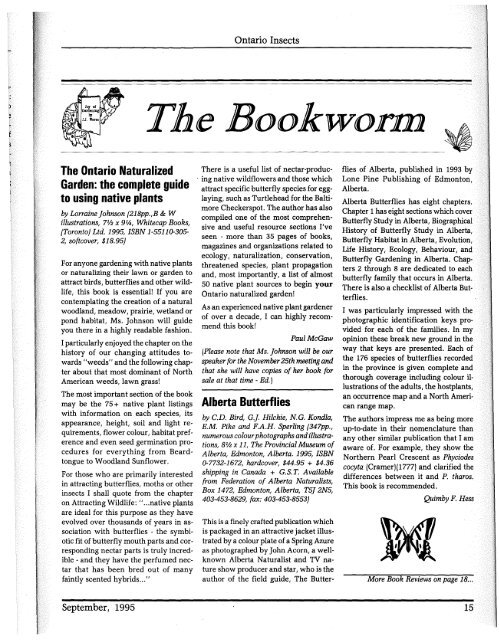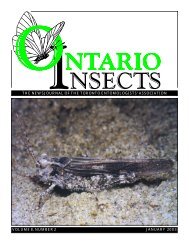Ontario InsectsThe NeLcontinued from previous pageBUGNET: has been formed to meet theneed for a "non-professional" entomologymailing list, Le. to serve as a resourcefor teachers and bug enthusiaststo ask questions to professional entomologists.To subscribe, send an emailmessage to listproc@listproc.wsu.eduwith a blank subject line and body textconsisting of SUBSCRIBE BUGNET JOHN DOEwhere John Doe is your real name. Formessages to the subscribers, send tobugnet@listproc.wsu.edu.DPLEX-L: is for use by teachers, researchers,students and others interested in theMonarch Watch and/or monarch biology.Contact Julie Ellis at jellis@kuhub.cc.ukans.edu for more information.ENTNET: is maintained by the EntomologicalSociety of America, and automaticallyprovides weekly updates of the up-coming ESA Annual Meeting, completetexts of the table of contents of ESAjournalsthat won't be published until threemonths later, listings of articles tentativelyscheduled for journals that willnot be printed for another five or sixmonths, weekly electronic versions ofthe ESA Newsletter, and more. To subscribe,send a message to listmgr@entsoc.org with the single line SUBSCRIBE ENTNET YOUR-REAL-NAME YOUR-EMAILADDRESS.ENTOMO-L: is maintained at the Universityof Guelph in Canada, and pertainsto entomology in general. To join thelist, send an e-mail message with a blanksubject line to listserv@uoguelph.cawith the text as follows: SUBSCRIBEENTOMO-L YOUR-NAME (where your-nameis your real name). You will then receiveregular messages on entomological topics(usually about 5-10 per day) fromother members in the group.MOSQUITO-L: is for the discussion of topicsrelated to mosquitoes (Diptera:Culicidae). Send an e-mail message tomosquito-I-request@iastate.edu with theword SUBSCRIBE in the body of the message(subject field will be ignored). Ifyour e-mail program automatically addsyour signature to the end of your message,put the word END on a separateline after the word subscribe. Once youare subscribed to Mosquito-L, sendinga message to mosquito-l@iastate.eduwill send your message to all the subscribers.If you prefer a digest version,send a message to mosquito-I-digestrequest@iastate.eduin lieu of the above.The list is maintained by John VanDykUvandyk@iastate.edu) at Iowa StateUniversity.MOTH@GYPSY: is a listserver that is dedicatedto exchange of information aboutthe gypsy moth world-wide. You cancontinued on page 19...More Trips...continued from page 13McGaw): Sharp-lined Yellow (Sicymacularia); Chickweed Geometer(Haematopsis grataria); Large Lace-border(Scapula limboundata); GrapeLeaffolder (Desmia funeralis).~Field TripBranchton, July 23,<strong>1995</strong>Bill EdmondsWe woke up Sunday morning to pouringrain in <strong>Toronto</strong>. We quickly turnedon the weather channel to try to determinewhat the weather was like in Cambridge.Rain and thunderstorms wereforecast. What should we do? Thosewho were coming that day started tophone us to find out if the trip was onor not. We hemmed and hawed and thendecided to go on with the trip but tochange the starting time to 11 :30 insteadof our intended 9:30. When we left14<strong>Toronto</strong> it was raining, butas we nearedCambridge the rain stopped. By the timewe all met at Tim Horton's, it seemedthat the rain was gone, and by 4 pm thesky was a perfect blue.There were 9 of us -- Nancy and myself,Paul McGaw, Caroline King,Quimby Hess, Jim Spottiswood, JohnPrideaux, Chris Rickard, and CharlesHeller. We saw 34 species between 12and 5 (much less than the 44 speciesthat we saw last year), but the seasonhad been a bit odd. Branchton is an oldrailway line. The ties were removedsome years ago, and the pathway leftgoes through some different habitats,though not much forest. There are a fewpatches of boggy area that are home tomany species, including the sedge skippers.Paul and Caroline pursued themoths and identified 10 of them. Thefollowing is a list of what we saw:Alfalfa Sulphur (4); Cabbage Whites (10);Mustard White (6); Pearl Crescent (10);Question Mark (1); Great Spangled Fritillary(9); Bronze Copper (1); AcadianHairstreak (11 including 2 mating pairs);Coral Hairstreak (1); Banded Hairstreak(3); Striped Hairstreak (1); BroadwingSkipper (37); Black Dash (21); NorthernBroken Dash (1); Tawny Edged Skipper(2); Crossline Skipper (1); Silver SpottedSkipper (1); Peck's Skipper (1); Dun Skipper(3);Delaware Skipper (8); EuropeanSkipper (1); Dion Skipper (1 female);Common Sooty Wing (1); NorthernPearly Eye (2); Wood Nymph (4); EyedBrown (10 including one mating pair);Spring Azure (4); Eastern Tailed Blue (4);Viceroy (2); Monarch (5); AmericanPainted Lady (1); Baltimore (4); EasternBlack Swallowtail (3 + 1 larva on wildcarrot); Tiger Swallowtail (2)~Hummingbird Clearwing; ForageLooper; Large Lace Border; EuropeanCorn Borer; Slant lined Owlet; ConfusedEusarca; Helvibotys helvialis; CeleryLooper; Reversed Haploa; GrapeLeaffolder moth (Desmia funeralis)Michael van der PoortenSeptember, <strong>1995</strong>
Ontario InsectsThe Bookworm ~The Ontario NaturalizedGarden: the complete guideto using native plantsby Lorraine Johnson (218pp.,B & Willustrations, 7~ x 91,4, Whitecap Books,(<strong>Toronto</strong>) Ltd. <strong>1995</strong>, ISBN 1-55110-3052, softcover, $18.95)For anyone gardening with native plantsor naturalizing their lawn or garden toattract birds, butterflies and other wildlife,this book is essential! If you arecontemplating the creation of a naturalwoodland, meadow, prairie, wetland orpond habitat, Ms. Johnson will guideyou there in a highly readable fashion.I particularly enjoyed the chapter on thehistory of our changing attitudes towards"weeds" and the following chapterabout that most dominant of NorthAmerican weeds, lawn grass!The most important section of the bookmay be the 75 + native plant listingswith information on each species, itsappearance, height, soil and light requirements,flower colour, habitat preferenceand even seed germination proceduresfor everything from Beardtongueto Woodland Sunflower.For those who are primarily interestedin attracting butterflies, moths or otherinsects I shall quote from the chapteron Attracting Wildlife: " ...native plantsare ideal for this purpose as they haveevolved over thousands of years in associationwith butterflies - the symbioticfit of butterfly mouth parts and correspondingnectar parts is truly incredible- and they have the perfumed nectarthat has been bred out of manyfaintly scented hybrids..."There is a useful list of nectar-produc-. ing native wildflowers and those whichattract specific butterfly species for egglaying,such as Turtlehead for the BaltimoreCheckerspot. The author has alsocompiled one of the most comprehensiveand useful resource sections I'veseen - more than 35 pages of books,magazines and organizations related toecology, naturalization, conservation,threatened species, plant propagationand, most importantly, a list of almost50 native plant sources to begin yourOntario naturalized garden!As an experienced native plant gardenerof over a decade, I can highly recommendthis book!Paul McGaw(Please note that Ms. Johnson will be ourspeaker for the November 25th meeting andthat she will have copies of her book forsale at that time - Ed. )Alberta Butterfliesby C.D. Bird, G.]. Hilchie, N. G. Kondla,E.M. Pike and F.A.H. Sperling (347pp.,numerous colourphotographs andillustrations,8lh x 11, The Provincial Museum ofAlberta, Edmonton, Alberta. <strong>1995</strong>, ISBN0-7732-1672, hardcover, $44.95 + $4.36shipping in Canada + G.S. T. Availablefrom Federation of Alberta Naturalists,Box 1472, Edmonton, Alberta, T5J 2N5,403-453-8629, fax: 403-453-8553)This is a finely crafted publication whichis packaged in an attractive jacket illustratedbya colour plate of a Spring Azureas photographed by John Acorn, a wellknownAlberta Naturalist and TV natureshow producer and star, who is theauthor of the field guide, The Butter-flies of Alberta, published in 1993 byLone Pine Publishing of Edmonton,Alberta.Alberta Butterflies has eight chapters.Chapter 1has eight sections which coverButterfly Study in Alberta, BiographicalHistory of Butterfly Study in Alberta,Butterfly Habitat in Alberta, Evolution,Life History, Ecology, Behaviour, andButterfly Gardening in Alberta. Chapters2 through 8 are dedicated to eachbutterfly family that occurs in Alberta.There is also a checklist of Alberta Butterflies.I was particularly impressed with thephotographic identification keys providedfor each of the families. In myopinion these break new ground in theway that keys are presented. Each ofthe 176 species of butterflies recordedin the province is given complete andthorough coverage including colour illustrationsof the adults, the hostplants,an occurrence map and a North Americanrange map.The authors impress me as being moreup-to-date in their nomenclature thanany other similar publication that I amaware of. For example, they show theNorthern Pearl Crescent as Phyciodescocyta (Cramer)(1777) and clarified thedifferences between it and P. tharos.This book is recommended.Quimby F. HessMore Book Reviews on page 18...September, <strong>1995</strong>15



